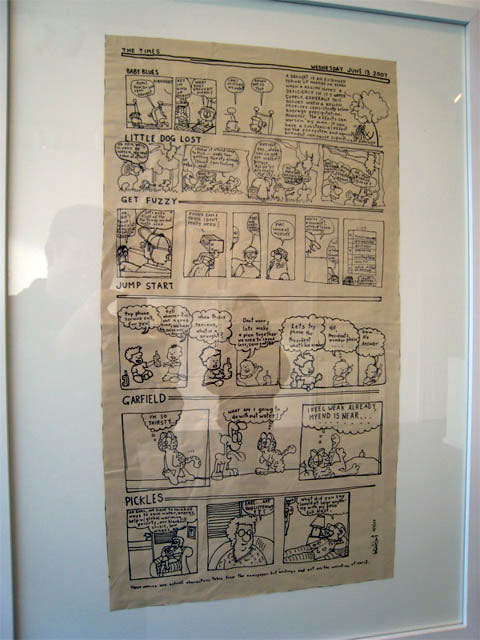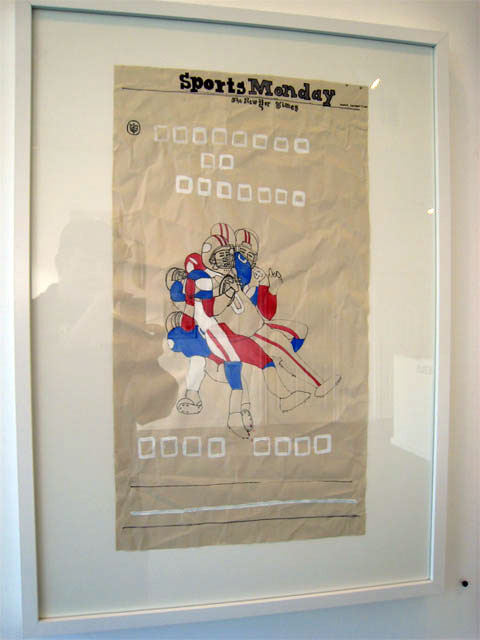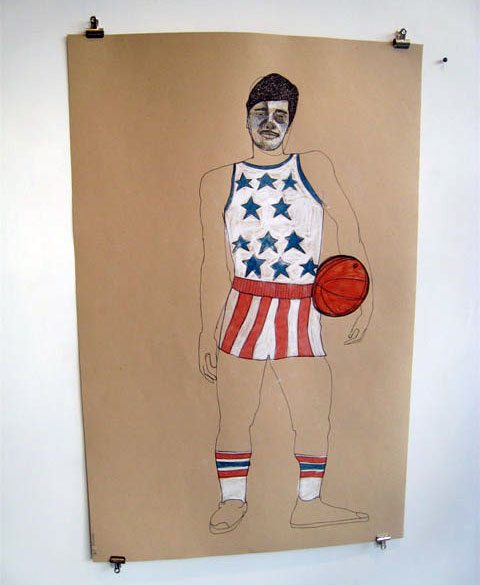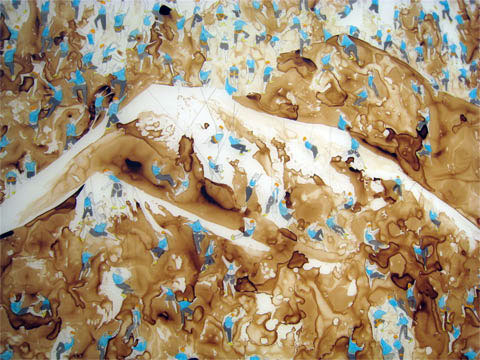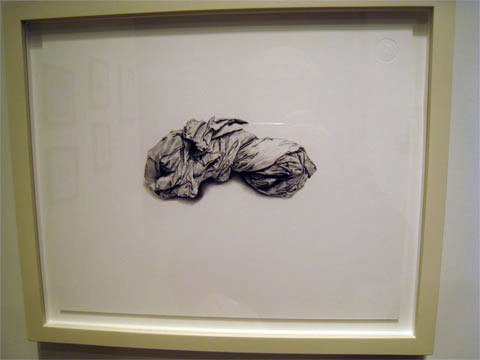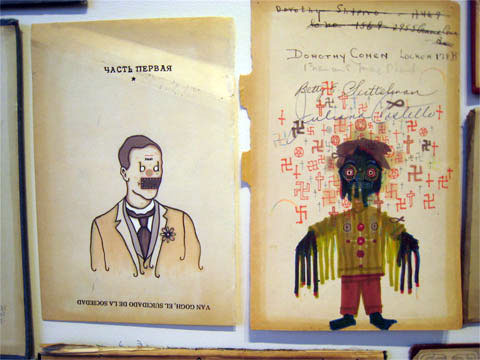
A few weeks ago, I was watching the monthly
KQED video podcast, "
Gallery Crawl", which usually covers art galleries in the SF Bay Area. This time they visited a couple of galleries in
Second Life. Which is a virtual place. It's real enough, though . . .
I'd heard of Second Life, but had never visited before. I thought it was just a fantasy version of a singles bar. Even so, the art galleries looked interesting and I wanted to explore them myself. So I signed on and went into Second Life.
There is most definitely a wealth of art in Second Life, but before I get to that, let me say a few things about Second Life, as a place, as an experience. From my casual observations, it seems to me that the primary activities of the citizens of Second Life (in order of importance) are shopping, hanging out with friends, sex play, making art, and finding information. Vast amounts of land are filled with shopping malls, boutiques, and retail outlets (just like real life?) There are plenty of public gathering places like parks, beaches, museums, libraries, as well bars, clubs, theaters and the like. If you're into X-rated entertainment - it's easy to find, if you're not - it's easy to avoid. A variety of corporate and non-profit organizations have set up libraries, museums, universities, and interactive learning stations. Second Life reminds me of the early days of the web, but in 3-D, and it's much more interactive.

And for now at least, Second Life is heavily influenced by artists. It's a visually rich environment. If you're interested in architecture, fashion, landscaping, kinetic sculpture, color, pattern, design - you'll get hours of pleasure just wandering around the place, looking at everything. Imagine a world where artists got in at the beginning and had a say in how the place was built - this is it.
So it's no surprise that, not only is there plenty of public art, but there are tons of art galleries and quite a few art museums. Just like in the real world, some galleries are little more than souvenir shops for the tourists, while other galleries sell likable, forgettable paintings and photos (usually copies of real world works) and a few galleries show exciting, innovative work. The art museums are more conservative, but when you're talking about the Sistine Chapel (
seriously) who cares?

KQED highlighted the galleries on Odyssey island, and justifiably so - it's an interesting space, with a couple of big galleries, some outdoor sculptures, an auditorium, and a strong emphasis on performance art. One gallery held photos of famous historical performance art pieces, next to photos of Second Life reenactments of scenes like Chris Burden's 1971 shooting.
One of the biggest galleries I've seen in Second Life is the Ginsberg Art Center, which is 6 floors of contemporary painting, photography and sculpture. It took me four visits to see the whole thing. Most of the paintings and photography look like they were brought over from real life. Here's a painting by Tommy Parrott (on right, below) called "3 birds and 2 beetles"- no other info available. Wall tags, and identifying info of any kind are somewhat lax in Second Life galleries. Sometimes, even in solo shows, I couldn't figure out who the artist was.

Some artists set up their own galleries, which operate like 3D portfolios. These places often did a better job of identifying the artist and providing web links to more info and contact details. For instance, on the island of Artropolis, artist Esch Snoats (aka Todd Tevlin) had a couple of signs up in his display area,
"Esch Snoats in offline, touch here to leave a message for later." and
"Want the real thing? Visit Esch's website to buy real life prints of his artwork! Click for website." Next door at the Gespot Gallery, was a space full of drums and colorful, symbolic narrative paintings (or collages?) for sale by Grimfiddle Dogpatch. Downstairs, next to a crowing rooster, I found his artist's statement,
web link and real life name, Mark C. Meyers. Incidentally, Artoplolis has a free boat tour around the island. I took it at night, with a full moon, lots of stars in the sky, water sounds all around - and it was quiet, restful, and gorgeous. Pick up the boat at the dock by the photo studio of Shoshanna Epsilon. On the other side of the island were inventive portraits by Wake Idler - 3-D and hologram blendings of multiple images. The artist had another piece next to her dockside gallery, a sculpture of an oil drum, called "The Price of Oil." An info card next to the piece said that:
This piece serves to hammer home the true price of oil. The concept came to me while driving (what else?) and listening to Billy Bragg's song, "The Price of Oil." To get this piece, someone must die. Yes, die. This way we won't forget the thousands of Americans and the tens of thousands of Iraqis who have already died in the Second Gulf War. I don't want this going to alts, so your Second Life account must be real. To be real, your Second Life account must fufill the following characteristics:
1.) You must have been a member of Second Life for more than six months.
2.) You must either have payment info on record or rent land in a private island that doesn't require payment info on record.
3.) You must designate your heir to receive this work.
And of course ... you must die.
After you are gone from Second Life and have been gone from Second Life for 30 days, your designated heir will receive the piece. There will be no other charge for the item.
And then there are the out-of-gallery art experiences. One evening on Blackrock island, I ran into a guy, named Zenos Zond. He told me he was an artist, and when I asked him where I could see his work, he looked around and said, "Let's move over there, where there's more room." We walked a little ways to an open meadow and he began to conjure sculptures and paintings. One by one, an artwork would appear before us, I could walk around it, inspect it closely, ask him questions, and then it would disappear, to be replaced by another piece. Wow - talk about a spectacular portfolio presentation . . .

There are two museums in Second Life that I keep visiting again and again. The
Dresden Museum is a recreation of the Old Masters Galleries in the real life city of Dresden and all 750 masterpieces in the permanent collection are on display. I still haven't seen everything in this building, and almost everything there is stunning. Yes, it's true that you can't get close enough to see the brush strokes and the accuracy of the colors depends on your monitor (among other things) but there's still a lot to be said for walking into a room full of great paintings that have been placed together by some kind of intelligent design . . . pausing in front of one, then stepping back to take in the pieces next to it, then stepping forward to check out a detail in one of them. It's an experience that you don't get in a book or in an online inventory where you click-through to the next slide. As a bonus, the Second Life Dresden museum gives away free t-shirts when you enter and the audio-guides are free, too.
Vassar College has established a campus in Second Life and on that campus, they reconstructed the
Sistine Chapel. The really cool thing about this version of the Sistine Chapel is that you can fly up near the ceiling and hover there while you take your time looking at the frescos. Over in the Castle Vassar art gallery, they have life-sized reproductions of the Leonardo DaVinci's Last supper and Jan van Eyck's Ghent Altarpiece. The altarpiece is constructed so that you can open and close the side panels to see the work on both sides, and get an idea of the work as an single construction. I guess it sounds silly, but I got big kick out of manipulating the panels and getting up really close to the panels.
There are a few things that Second Life is missing:
-Smog, traffic, parking problems. There are almost no roads, and cars are novelty toys, because you can get around by walking, flying or teleporting. (And climbing the pyramid at Chichen Itza doesn't make you short of breath.)
- Weather, except as a controlled event, designed for your education and enjoyment.
- Sewage systems, landfills, power plants, except as art installations.
- Taste, smell, touch. Your experience of Second Life is mediated by your computer, just as your experience of the Real World is mediated by your body. The brain is the most important element in both places.

If you're thinking of checking out Second Life for the first time, you'll need a high-speed internet connection and a computer with a pretty fast graphics processor (ie: able to watch streaming video.) Go to
SecondLife.com and sign up for a new account (it's free to visit, it costs money to become a resident.) When you enter Second Life that first time be prepared to spend about an hour making your avatar and learning how to use it - how to walk, talk, and so forth. Also be ready to pick a name for yourself. First you will have to choose your last name from list of names presented to you and then you can invent your first name (and all the usual ones are taken.) If you get there, look me up - my Second Life name is Annalee Contepomi. I've been thinking of leading a gallery crawl in Second Life, and if there's enough interest, I might just do it.
(The images are snapshots from my most recent visit to Second Life. More photos and captions identifying the artists on my Second Life Flickr page.)
 Ed Ruscha, "Parts Per Trillion,” 1987, acrylic on canvas, 50 by 120 inches. Collection SFMOMA, purchased through the Phyllis C. Wattis Fund for Major Accessions.
Ed Ruscha, "Parts Per Trillion,” 1987, acrylic on canvas, 50 by 120 inches. Collection SFMOMA, purchased through the Phyllis C. Wattis Fund for Major Accessions.




















































